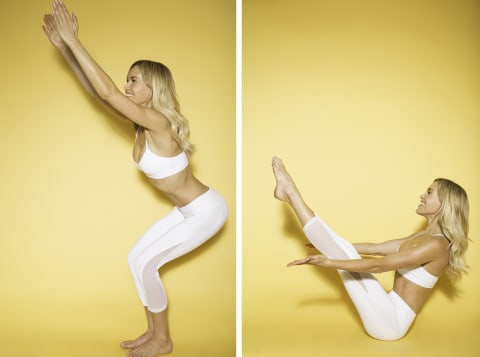If you’re in the market for a fast-paced flow, consider vinyasa yoga your go-to version. Before you try it out—in a studio or virtual class—learn exactly what this type of yoga entails, its potential health benefits, and how to practice. Tara Stiles, mbg collective member and founder of Strala Yoga agrees. “Allow your body to move along with the ride of your breath,” she says in mbg’s Complete Guide to Yoga class. “So your inhale is literally lifting you and opening you into movement, and your exhale is literally twisting you or moving you a little farther along, whatever the movement is.” This dynamic movement can flow at a rapid pace—or it can be really slow. Whatever the speed, all vinyasa classes share “that element of moving dynamically with the breath,” says Stiles. In some vinyasa classes, the teacher might call out poses with the expectation that students will know how to do them. In other vinyasa classes, like in alignment-based vinyasa classes, the teachers will provide more instructions on how to perform postures. There are also vinyasa classes that combine vinyasa with other types of yoga, like yin or restorative, and some vinyasa studios that are heated, says Maria. As you move through your vinyasa class, don’t push yourself into poses you don’t know. If all of your classmates are busting out headstands, for example, and you’ve never done one before, now is not the first time to try. Instead, respect your current level, and if you need to take a breather, do so without worry. “It’s totally acceptable to take a break,” says Maria. “It’s respected; it shows that somebody is taking care of themselves.” Here are a few examples of poses and sequences you may see in class (demonstrated by yoga instructor Claire Grieve): During your vinyasa class, you might hear the teacher say the word “vinyasa,” which generally cues people to perform a repetitive sun salutation sequence that starts with a chaturanga and ends in a downward-facing dog. If this happens and you’re confused, simply follow along as best you can, Maria suggests. Or you can use this time to do your own thing entirely, like hold a plank, move to downward dog, or rest in child’s pose. If you’re brand-new to yoga, you may want to take a beginner-friendly class (like some hatha classes) or an Iyengar class (a form of hatha that focuses on proper alignment and precise technique) before jumping into vinyasa, says Maria. That way you can correctly learn poses before practicing them in the quick-flow format of vinyasa. Lastly, strenuous, fast-paced vinyasa classes aren’t a good idea if you have knee, shoulder, or neck issues, says Maria. And of course, if you do have any type of injury, chronic illness, or history of pain—of if you’re pregnant—you should check with your doctor before trying vinyasa for the first time.





